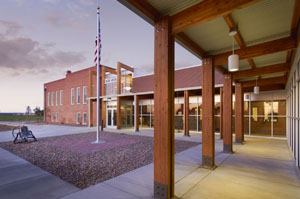Alta Vista Charter School in Lamar has been named the first project in the U.S. to attain the Verified Leader certification by the Collaborative for High Performance Schools (CHPS). It recognizes AVCS as a healthy, high-performance, green school.

CHPS is a national organization that optimizes K-12 learning environments and improving student performance and the entire educational experience by building the best possible schools. Similar to LEED, CHPS provides a regional focus for sustainability.
“We are thrilled to see this amazing transformation and have enjoyed our first year of occupying the school with a healthy and sustainable environment for our students and faculty,” said Talara Coen, principal for Alta Vista Charter School.
Designed by SLATERPAULL Architects and constructed by JHL Constructors, both of Denver, AVCS is a K-6 charter school in southeastern Colorado. The CHPS-certified project includes a 23,000-sq-ft building addition and renovation of the original 1917 schoolhouse to create a high performance environment for students, teachers and faculty. The school received a grant from the Colorado Dept. of Education’s Building Excellent School’s Today (BEST) program and additional funding from the Gates Family Foundation.
The high-performance design features at AVCS will reduce energy consumption by 54% with significant savings to the school, as compared to an average school. A high-performance envelope coupled with a geo-exchange ground-source loop heating and cooling system helped achieve the savings.
In addition, to lower operational costs the school has utilized exceptional daylighting strategies, which not only allows for lights to be turned off during the day, but also helps create a healthy learning environment by fostering increased student productivity and higher test scores.
Rapidly renewable and recycled content materials were used throughout the building during construction and more than 70% of the construction waste was recycled or re-used within the community. Unique to CHPS, the team also employed the Flex Energy Tool to consider energy strategies for the future.

Post a comment to this article
Report Abusive Comment